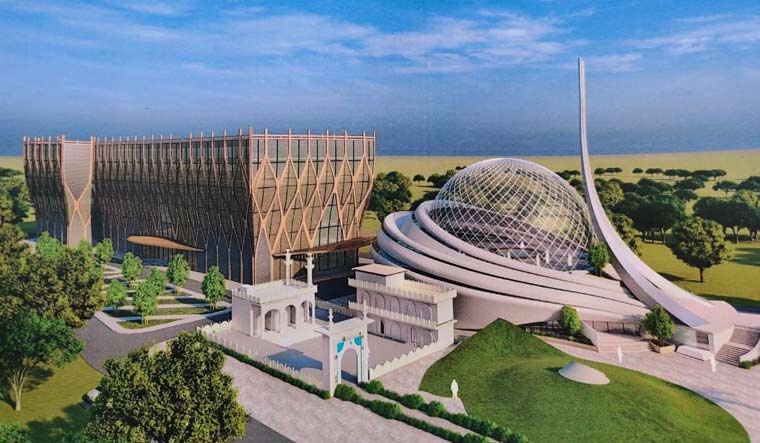The Indo Islamic Cultural Foundation (IIFC) today revealed the design of the Dhannipur Mosque complex at a press conference in Lucknow. The much-anticipated design consists of two structures—one which will house the mosque while the other will have the administrative block, the multi-specialty hospital, the library, the archive, the publication house and the community kitchen.
The press meet was virtually addressed by Syed Mohammed Akhtar, dean of the Jamia Millia School of Architecture, who is the architect for the complex, and Pushpesh Pant, retired professor of international relations, Jawaharlal Nehru University. It was attended by the IIFC spokesperson Athar Husain and chairperson of the All India Sunni Central Waqf Board, Zufar Ahmad Faruqi among others.
also read
- Controversy over Ram Mandir tableau for India Day parade in New York explained: 'Target of hate crime'
- Like Ayodhya, INDIA bloc will defeat Modi, BJP in Gujarat: Rahul Gandhi
- Ayodhya Ram Path waterlogging: UP govt suspends 6 officials, undertakes repair works
- Ayodhya Pran Pratishtha: 15 Indian sporting icons invited for Ram Temple consecration on Jan 22
- Ayodhya: 100 chartered flights expected on Jan 22; 10,715 AI cameras to keep watch on city
Before revealing the design, Akhtar showed images of mosques from around the world, including those from Germany, Kosovo, Dubai, Istanbul and said, “These are some contemporary expressions of mosque designs. In India too, for instance, the first eco-friendly mosque is in Karnataka. This, too, will not be a mosque with a nostalgic vocabulary.”
The mosque will cover 3,500 square metre of the five-acre plot of land that has been allotted by the state government pursuant to the Supreme Court’s judgment on the Ayodhya title suit. It will have a ground floor and a mezzanine floor with a separate and flexible (in terms of how many can gather at a time) section for women. At one go, the masjid will be able to hold 2,000 people within it.
Responding to a query on why the masjid did not have a dome, Akhtar said, “A dome is a traditional expectation of what a masjid should look like. Like arches, those were built at a time when Islam was growing. But Islam is not confined by a period or a region. To confine it to what was acceptable in the medieval ages is a conspiracy against Islam.”
Pant added that traditional vocabularies of design were always challenged and had evolved. “We must not remain captives of our past. This design captures the dream of excellence we have shared. We must break out of the chains that bind our legs, clear the cobwebs off our minds. Places of worship in all religions have evolved with time. Look at the gurudwara of Shri Hemkund Sahib, for instance—it has a pentagonal structure unlike traditional gurudwaras.”
“We must rise above mere brick and mortar notions to look at the larger aspects of what places of worship were supposed to be about. They were places for communities to gather and that itself is a form of worship,” he added.
While the masjid will be completely self-sufficient in energy, the hospital complex will also be so, as far as possible. The hospital will have around 250 beds and cover an area of 24,150 square metres with a basement of 9,000 square metres. The building will have a ground floor and four more floors. The archive will be spread in 500 square metres and have an auditorium.
Husain said that two dates—January 26 and August 15—had been designated as start dates for the building. However, this would depend on when the design would receive approval. “There are no better dates than these for our country,” said Husain.
Responding to a query about whether the chief minister of the state would be invited for the foundation laying ceremony, Husain said, “In no school of Islam is the laying of the foundation of a masjid meant to be a large affair. But when we have something to show for, like our hospital, we will invite everyone to it.”
While the entire complex will be constructed simultaneously, the IIFC has emphasised that it is interested in getting the multi-specialty hospital going as soon as possible as the area in which the complex is situated has poor health facilities. “Rough calculations say that just one bed in such a hospital costs Rs 50 lakh. Thus, just the hospital is a Rs 100 crore-plus project. It will take at least a year to be constructed and another to be fully equipped, depending on how we raise the funds.” The masjid is likely to take six months to complete.
On the name of the complex, Husian was clear that it would not be labelled after any emperor or king. “My proposal is that it be called the Dhannipur complex,” he said.







